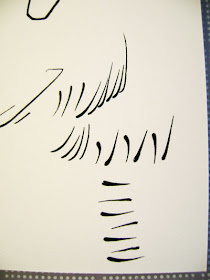 This week: Draw in any direction with a nib
This week: Draw in any direction with a nibFor reasons I cannot understand, there are still people who think you can only make downward strokes with a pen, and that to get an upward stroke, you have to physically turn the page over and draw a downward stroke. There are even still professionals who've used pens for decades who think this. There are books that supposedly teach you how to use a pen that say this. I don't know how people can have used this tool for so long without having figured out the very simple solution to the problems. For those of you who've never used a nib before, let me bring you up to speed on what I'm talking about:
A nib is a pointy tool made out of two needle-sharp barbs of metal that sit up against one another, forming a channel that ink flows through. When you hold a nib in a resting position, the nib is at an angle, with the bottom concave side facing the page, and the tip of the tip pointing at the top of the page. With the nib in this position, as illustrated in Fig 1.2, you can only draw the nib downward, or in a downward-ish direction. If you try to pull it to the side, it's tip will thrust into the page and stop. Here I've shown the maximum range of angles I can draw with my nib facing straight up before the tip catches the page. (Fig 1.1) As you can see, this particular nib can actually draw up on the left side, probably from wear on that side. If you had a really sharp nib like a crowquill you'd have way less range if you tried this.

So what happens if you push that nib up anyway? Either your nib will skip and shoot ink all over the page like this,
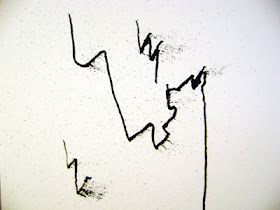 Or it will flat out stab holes into the page, like this, or both. So, can anyone see the solution to this problem? If you hold the nib perfectly straight up and down when you draw, you can only draw downward lines. Can anyone think of the solution here? Anyone?
Or it will flat out stab holes into the page, like this, or both. So, can anyone see the solution to this problem? If you hold the nib perfectly straight up and down when you draw, you can only draw downward lines. Can anyone think of the solution here? Anyone?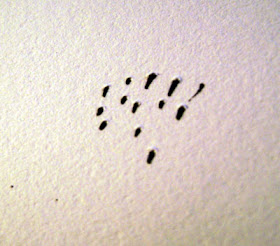 DON'T HOLD THE NIB STRAIGHT UP AND DOWN. You have a hand with joints and stuff, right? Your drawing hand isn't a laser printer on a track that only goes back and forth, right? Move your hand around! It's as easy as that! The pen can only move away from the tip of the nib, so change direction of the nib to draw in different directions! What you see below is pictures taken while making one, uninterrupted line. The paper was never moved, the nib never lifted:
DON'T HOLD THE NIB STRAIGHT UP AND DOWN. You have a hand with joints and stuff, right? Your drawing hand isn't a laser printer on a track that only goes back and forth, right? Move your hand around! It's as easy as that! The pen can only move away from the tip of the nib, so change direction of the nib to draw in different directions! What you see below is pictures taken while making one, uninterrupted line. The paper was never moved, the nib never lifted: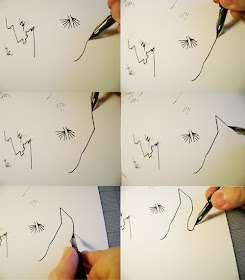 Easy! Depending on how you hold your pen, you may need to grip it differently to be able to do this. Everyone holds their pen differently, but just to give you an idea of how I do this, I'll show you how I hold my pen. You'll probably have to find a different way, because your hands are probably different than mine.
Easy! Depending on how you hold your pen, you may need to grip it differently to be able to do this. Everyone holds their pen differently, but just to give you an idea of how I do this, I'll show you how I hold my pen. You'll probably have to find a different way, because your hands are probably different than mine.In Fig 2, you can see that the two fingers actually holding the pen stalk are my thumb and middle finger. The two fingers clamp against the pen stalk, holding it. They move back and forth for short strokes, where I often won't move my hand or arm at all. And my thumb will shift up or town to swing the pen stalk around, which reorients the nib. All my other fingers are doing is stabilizing my hand at the desired height or steadying the pen. The meeting of these two fingers is the pivot point for the pen to change directions, as you can see.
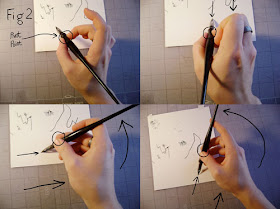 Using this technique, I can draw very controlled lines of any length in any direction I want. I may still move the page around a little if it's more comfortable, especially on very tricky curves, but it's almost never necessary.
Using this technique, I can draw very controlled lines of any length in any direction I want. I may still move the page around a little if it's more comfortable, especially on very tricky curves, but it's almost never necessary.